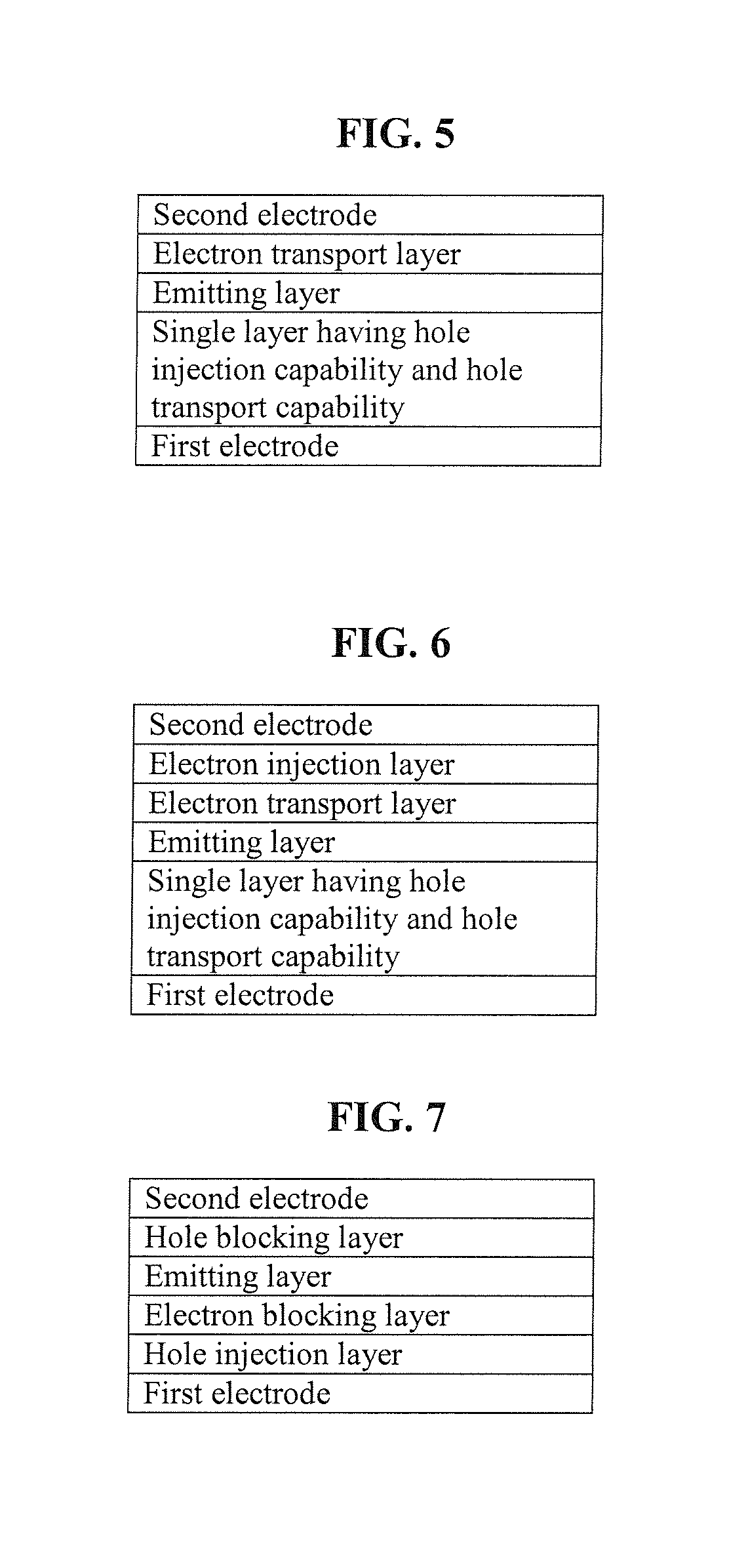Carbazole-based compound and organic light-emitting device including organic layer including the carbazole-based compound
a carbazole-based compound and organic light-emitting device technology, which is applied in the direction of discharge tube luminescnet screens, other domestic articles, organic chemistry, etc., can solve the problems of power consumption characteristics, life, efficiency, etc., and achieve high glass transition, good charge transport capability, and electric stability
- Summary
- Abstract
- Description
- Claims
- Application Information
AI Technical Summary
Benefits of technology
Problems solved by technology
Method used
Image
Examples
synthesis example 1
Synthesis of Compound 1
[0059]Compound 1 was synthesized according to Reaction Scheme 1 below.
Synthesis of Intermediate A
[0060]1,3,5-tribromobenzene (6.3 g, 20 mmol) was dissolved in diethylether (50 ml). The reaction solution was cooled to −78° C., and n-butyllithium (8.8 ml, 22 mmol, 2.5M in hexane) was gradually added thereto. The reaction mixture was stirred at −78° C. for one hour, and copper chloride (II) (2.96 g, 22 mmol) was added thereto at −78° C. The reaction solution was stirred for five hours and washed with distilled water and ethylacetate at room temperature. The obtained ethylacetate layer was dried over MgSO4, and then dried under a reduced pressure to obtain a crude product. The crude product was purified by silica gel column chromatography to give intermediate A as a white solid (3.74 g, yield: 80%). The structure of intermediate A was determined by 1H NMR. 1H NMR (CDCl3, 300 MHz) δ (ppm) 7.69 (s, 2H), 7.58 (s, 4H); 13C NMR (CDCl3, 100 MHz) δ (ppm) 141.7, 133.8, 12...
synthesis example 2
Synthesis of Compound 13
[0065]Compound 13 was synthesized according to Reaction Scheme 2 below.
Synthesis of Intermediate E
[0066]Carbazole (16.7 g, 100 mmol), iodobenzene (26.5 g, 130 mmol), CuI (1.9 g, 10 mmol), K2CO3 (138 g, 1 mol), and 18-Crown-6 (530 mg, 2 mmol) were dissolved in DMPU (500 ml), and the reaction mixture was heated at 170° C. for eight hours. The reaction solution was cooled to room temperature and a solid material was filtered out. A trace amount of an ammonia solution was added to the filtrate, and the resultant solution was extracted three times with diethylether (300 ml). The obtained diethylether layer was dried over magnesium sulfate and then dried under a reduced pressure to obtain a crude product. The crude product was purified by silica gel column chromatography to give intermediate E as a white solid (22 g, yield: 90%). The structure of intermediate E was determined by 1H NMR. 1H NMR (CDCl3, 300 MHz) δ (ppm) 8.12 (d, 2H), 7.58-7.53 (m, 4H), 7.46-7.42 (m, ...
synthesis example 3
Synthesis of Compound 18
[0070]Compound 18 was synthesized according to Reaction Scheme 3 below.
Synthesis of Intermediates H and I
[0071]2,4,6-tribromotoluene (3.3 g, 10 mmol) was dissolved in diethylether (30 ml). The reaction solution was cooled to −78° C., and n-butyllithium (4.4 ml, 11 mmol, 2.5M in hexane) was gradually added thereto. The reaction mixture was stirred at −78° C. for one hour, and copper chloride (II) (1.48 g, 11 mmol) was added thereto at −78° C. The reaction solution was stirred for five hours, and washed with distilled water and ethylacetate at room temperature. The obtained ethylacetate layer was dried over MgSO4 and then dried under a reduced pressure to obtain a crude product. The crude product was purified by silica gel column chromatography and recrystallized from dichloromethane and hexane to give intermediate H (622 mg, yield: 25%) and an intermediate I (746 mg, yield: 30%) as white solids. The structures of intermediates H and I were determined by 1H NMR...
PUM
| Property | Measurement | Unit |
|---|---|---|
| temperature | aaaaa | aaaaa |
| thickness | aaaaa | aaaaa |
| temperature | aaaaa | aaaaa |
Abstract
Description
Claims
Application Information
 Login to View More
Login to View More - R&D
- Intellectual Property
- Life Sciences
- Materials
- Tech Scout
- Unparalleled Data Quality
- Higher Quality Content
- 60% Fewer Hallucinations
Browse by: Latest US Patents, China's latest patents, Technical Efficacy Thesaurus, Application Domain, Technology Topic, Popular Technical Reports.
© 2025 PatSnap. All rights reserved.Legal|Privacy policy|Modern Slavery Act Transparency Statement|Sitemap|About US| Contact US: help@patsnap.com



